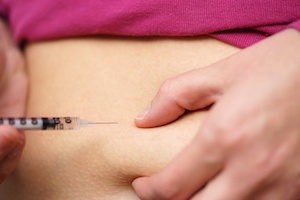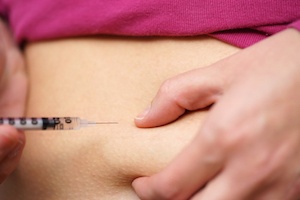We are experiencing a very high volume of calls and messages and ask for your patience. We will answer your portal messages within 48 hours.
We are experiencing a very high volume of calls and messages and ask for your patience. We will answer your portal messages within 48 hours.

 Fertility drugs have been routinely used for ovulation induction for many years now. Many women do not ovulate or ovulate infrequently. In these women, fertility drugs are used to make them ovulate regularly. Another group of patients from whom fertility drugs are used are those with unexplained infertility, mild male factor or endometriosis. In these patients, fertility drugs are used to stimulate the ovaries to produce more than one egg, increasing the chance of conception.
Fertility drugs have been routinely used for ovulation induction for many years now. Many women do not ovulate or ovulate infrequently. In these women, fertility drugs are used to make them ovulate regularly. Another group of patients from whom fertility drugs are used are those with unexplained infertility, mild male factor or endometriosis. In these patients, fertility drugs are used to stimulate the ovaries to produce more than one egg, increasing the chance of conception.
Intrauterine insemination (IUI) is often done in ovulation induction cycles. In this procedure, the semen sample is processed (“washed”) to separate the sperm from the rest of the seminal plasma. The “washed” sperm are then deposited inside the uterus using a long tube (catheter) around the time of ovulation. With IUI we bypass the (acidic and therefore harmful to sperm) vagina and the cervix (where the mucus can be hostile to sperm). By depositing the processed sperm in the “right” place at the “right” time we increase the chances of conception.
Oral medications (clomiphene citrate (CC), letrozole, tamoxifen) are usually the first line of treatment for ovulation induction. The pregnancy rate with these (in women who do not ovulate) is around 12% per cycle in patients under 35 years old, and around 8% per cycle in older patients. The pregnancy rates are lower in patients with unexplained infertility. Most pregnancies are in the first 3 – 6 cycles. The cumulative pregnancy rate with oral medications is around 30%.
Historically, the next step used to be the use of fertility injections (gonadotropins). These include follicle stimulating hormone (FSH; Gonal-F, Follistim) or human menopausal gonadotropin (hMG; Menopur). These injections contain higher doses of the same hormones the brain (pituitary gland) releases, are much stronger than the oral medications and have much higher pregnancy rate.
The downside is an unacceptably high and uncontrolled risk of multiple pregnancy (as high as 30%!) including high-order multiple pregnancy (triplets and higher). From a public health perspective, hospital expenses for each twin or triplet infant are several times that of a singleton, and lifetime costs to society (healthcare system and the community) could be 100–200 times higher compared with a singleton pregnancy. Therefore, avoiding multiple pregnancy with fertility treatment should be a major goal of all clinics.
The question that needs to be addressed is: Does the benefit of gonadotropin stimulation/IUI outweigh the risk?
One way of reducing the risk of multiple pregnancy in fertility gonadotropin/IUI cycles is to start with low doses of the medication with incremental (low and slow) increases in an effort to induce ovulation of a single egg (mono-follicular). This is often attempted in patients with polycystic ovary syndrome (PCOS) who do not ovulate with oral drugs. Studies have shown that even with this strategy, there remains a high rate of multiple pregnancy and a relatively low pregnancy rate (15% per cycle).
A recent trial (the AMIGOS trial) included >900 women, also aged 32 ± 4 years, with unexplained infertility who were randomized to oral medications (CC and letrozole) or to gonadotropins for ovarian stimulation and IUI. Gonadotropin/IUI had a cumulative pregnancy rate (PR) during four cycles of 35.5%, and a multiple birth rate of 32% including 10 sets of triplets!
On the other hand, in vitro fertilization (IVF) technology has advanced dramatically since 1999. Current IVF PRs in this age group (32 ± 4 years) with a single fresh or vitrified/warmed blastocyst transfer should be in the range of 50%. The cumulative single cycle PR in this age group, considering elective single fresh and frozen transfers, is likely closer to 80%–90%. Therefore, a single IVF cycle in a young patient should result in a success rate about three times higher than the cumulative PR of four gonadotropin/IUI cycles and without the risk of multiple gestations.
An IVF cycle costs more than a CC/IUI or gonadotropin/IUI cycle. However, when the cost is calculated per pregnancy, IVF is cheaper than the other two options. This is more so if the cost of raising twins (or higher) is included in the calculation. IVF cycles, however, are more invasive, involve more intense monitoring and can be more stressful.
At InVia Fertility Specialists, we have been routinely recommending IVF as the next step in patients who fail to conceive with 3 – 6 oral drugs/IUI cycles. Even insurance companies are now routinely accepting this step.
We believe there is very limited (if any) place for gonadotropin stimulation and IUI in women with unexplained infertility, or in women with PCOS resistant to oral medications. IVF with elective single embryo transfer is now the treatment of choice. To the gonadotropin injections and IUI option, we say – RIP!

Entire Website © 2003 - 2020
Karande and Associates d/b/a InVia
Fertility Specialists
